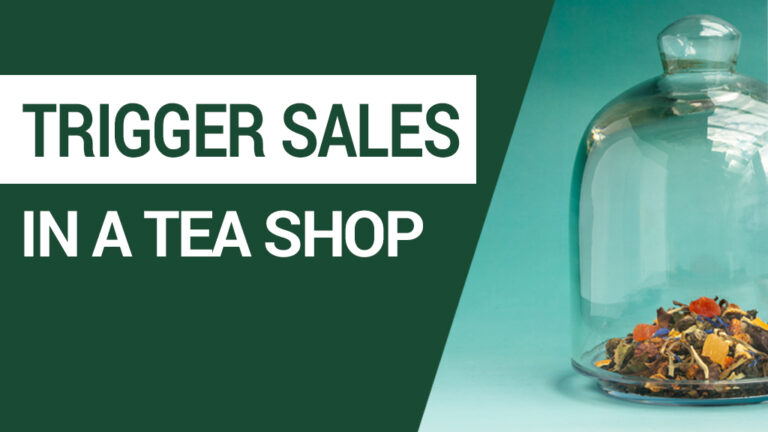You read it well:
You need 1,000 loyal customers to run a thriving tea shop.
And by “loyal”, I mean regular customers.
But let’s clear one thing first. Why should you care about loyalty in the first place?
3 reasons:
- You don’t run out of customers in your area,
- They spread the word. Loyal customers are your best ambassadors,
- Selling gets easier and people spend more. Because regular shoppers have trust in you and your products.
Okay, Loyalty is important. But how did I come up with this magic number?
Table of contents
ToggleWhy 1,000 loyal customers?
Let’s do the math
My example considers a standard tea shop, i.e. specialized tea store in a mid-sized city in Western Europe.
It is “specialized” because it sells mainly loose tea and teaware. The surface is about 50-60m2 and not situated in the most expensive street of the city, but still in a good location.
What is the sales figure for this store, given that it has been running for several years, is profitable, and has 1 full-time employee in addition to the owner? About 180,000€ / year (VAT excl.).
A sustainable tea store can generate 190,000€/year.
Now consider a loyal customer coming a few times a year. Let’s say she spends a fair amount in your shop every year: 150€ (VAT excl). Some will pay more, some less. It’s all about the average.
1,000 loyal customers averaging 160€ of purchases a year generates 160,000€ / year.
This leaves you another 30,000€ to make with one-time shoppers.
One-time buyers spend less than regulars. Averaging a 30€ / customer seems appropriate.

These are the magic numbers a specialized shop needs to achieve:
- 1,000 regular customers, spending 160€ /year,
- 1,000 one-time buyers, spending 30€/year.
Loyal customers buy 5 times more than one-time buyers! It becomes clear why customer retention is key.
If I were you, I would now ask the following question:
You: “All of this is interesting, but how do I know that it applies 1-to-1 to my shop?”
Me: “You’re like a beacon in the infinite space. What a great question”.
You: “Thanks”.
Me: “De nada José.”
Adapt the numbers to your situation
I see 3 reasons for that:
One: It’s not your shop.
Turnover must be adapted to your city and street, your size, your prices, the number of employees, etc.
If your store is located in Paris, London or Munich, you’ll have to pay higher rents. The key money you spent was potentially much higher as well.
Maybe your shop is much smaller, or you’re selling online as well. This will have an impact on your figures.
Same with the customer spendings. If your average yearly ticket is higher than 150€ (excl. VAT), congrats! And you would need fewer loyal customers to reach the turnover in our example.
Two: Customer behavior is simplified.
One-time buyers vs. loyal customers.
But the point of theorizing is to simplify a complex subject that would otherwise be very difficult to understand.
Third: We’re talking here about a shop that lasts…
… But it won’t make you rich either. I’d say this example is probably the minimum you have to target to build a sustainable business. You’ll have to reach to the next level to really make more money out of it – assuming that’s your goal.
To sum up, it’s not a one-size-fits-all. It should be adapted to your case…
… and it’s a reminder to cultivate retention
It is the most important takeaway.
What does it mean for your business if customers don’t come back? If you have no stickiness?
It means:
- You need even more customers to make up for those who aren’t coming back,
- As a consequence, the number of people you can reach in your catchment area will eventually run out of steam,
- You have no Word-of-Mouth. If people don’t return to your shop, they probably won’t promote it to their friends and family.
You can see it in our calculation above. The more you have returning customers, the fewer customers you need overall.
Your main concern as a tea shop owner or manager should be customer retention.
And remember:
- 1,000 loyal customers is an approximation,
- You can aim for more or less depending on your situation,
- It’s a reminder that retention is critical to your success. Be intentional with customer loyalty.
1,000 represents your initial target when you launch your business. And reaching that number will be nothing but an achievement.
Conclusion
That’s your healthy goal:
1,000 loyal customers + 1,000 one-time shoppers
to reach about 190,000€ turnover/year.
That’s why customer retention is key to your success. You need fewer customers overall.
Not only do these people spend more because they have trust in you, they are also your ambassadors to friends, family, and peers. They create free word-of-mouth for you.
1,000 is not a must. But it’s a good ballpark to understand that you don’t need to convince the whole world to be a fan of your place.
Does this average shop not fit your exact situation? Then adapt slightly those numbers depending on your reality.
Do you have anything to add? Let us know by dropping a message in the contact form.
PS: Render unto Caesar the things that are Caesar’s
The 1,000 loyal customers for tea shops is not entirely my idea.
In 2008, Wired editor-in-chief Kevin Kelly wrote a seminal article entitled “1,000 True Fans”.
He was one of the first to see a coming revolution: You don’t need millions of fans to make a living as a creative anymore.
You just need 1,000 true fans. If you meet 2 criteria:
- You make $100 profit per fan each year,
- You have a direct relationship with the fans so they pay you directly.
Think of a music band. If you have intermediaries between you and your fans, you might earn only a few cents on each dollar they spend. You only have one solution: reaching hundreds of thousands of fans to compensate for what the intermediaries take.
Kelly’s proposal is an alternative path to success for creatives. You don’t need fame and success anymore to make a living. 1,000 true fans are enough.
At the time counter-intuitive and bold, the emergence of platforms like Patreon and micro-communities on social media proved he was right.
What about you?
You might not be a creative. You don’t have fans, but loyal customers. You have a business. Most importantly, you have a direct connection to your customers.
And the fundamental goal remains:
Maximise retention to get customers who spend more in your shop.




